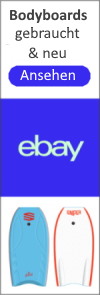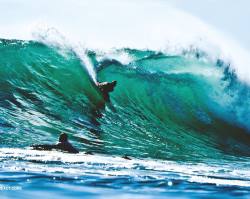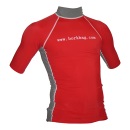

What is so intriguing about Bodyboarding? Is it the vague impression of danger that you sense when gazing at the powerful force of nature, the wave?
Is it the kick of the pace when the wave takes you away, in the middle of the sparkling salty water that takes you to the beach? Is it the aesthetic beauty of the sea and the waves
that you discover with all your senses?
 The taste of salt on your lips and the sun kissing your skin? Is it the radical manoeuvers in the waves and challenging other bodyboarders?
For sure, all these aspcets contribute to the fact that bodyboarding has become a very popular water sports. Also, you do not need a lot to practise, the equipment is not very expensive
compared to other sports, it is easy to transport, and also, the sport is easy to learn. Even beginners are able to catch their first waves in the white water afer some minutes or hours. That way,
a perfect water sports holiday is guaranteed.
The taste of salt on your lips and the sun kissing your skin? Is it the radical manoeuvers in the waves and challenging other bodyboarders?
For sure, all these aspcets contribute to the fact that bodyboarding has become a very popular water sports. Also, you do not need a lot to practise, the equipment is not very expensive
compared to other sports, it is easy to transport, and also, the sport is easy to learn. Even beginners are able to catch their first waves in the white water afer some minutes or hours. That way,
a perfect water sports holiday is guaranteed.

Although many manufacturers use many different names for their materials and construction methods which are even sometimes invented in order to stand our from the competition, you can distinguish between some basic materials and production ways that offer different qualities and advantages.
The most striking difference that is also decisive for the price range and the performance. The cheapest core that only has a very limited use for bodyboarding is the EPS Core. This is a highly compressed polystyrene that is very cheap to produce but unfortunately not very tough. Especially heavy surfers are likely to break their boards as soon as they leave the white water zone and go into the real waves. That is why you should consider board cores made ofPolyethylene (PE) or Polypropylene (PP) if you want to do some serious bodyboarding and are not only looking for a one-season beach toy. While PP Boards are even more resilent, long-lasting and only have half the weight of a PE board, they have the disadvantage that the lose stiffness in colder water and therefore have worse flex qualities. This is why for European spots, a PE core is more suitable even though the general qualities are not exactly as good as for PP cores.

The bodyboard bottom should be as smooth and robust as possible. After all, a bodyboard bottom could have ground contact from time to time if you are not careful. Depending on the type of beach, this could be problematic for your board lifetime. In order to have the desired qualities, many brands use HDPE (High-Density Polyethylene), a plastic plate that is very smooth an with slight flex qualities that gets laminated into the bodyboard bottom. When it comes to speed and solidity, only Surlyn can beat the HDPE performance. But is is also much more expensive. These kinds of bottom materials are defined as Slick.
The tail design which defines the shape where the bodyboard adapts to the surfer body has a major impact on the ride characteristics. So, it is important to choose the right board with regard to the tail design.
A "normal" nose width would be about 13" (i.e. about 33 cm). Nose widths below this are considered as rather narrow.
To sum it up: If you are a beginner and looking for a bodyboard buyers' advice, I would choose a bodyboard with a crescent tail and a wide nose.


Insbesondere bei Bat Tail Boards, bei denen die Kontrolle und der Geradeauslauf auf Grund der Tail-Form problematisch ist, aber auch bei anderen Bodyboards werden Channels
auf der Unterseite integriert. Hierbei handelt es sich um längs verlaufende kanalförmige Auswölbungen an der Unterseite des Boards. Entgegen eingiger Vorurteile dienen Channels
nicht dazu, die Endgeschwindigkeiten zu erreichen, sondern das Gegenteil ist der Fall: Die größere Oberfläche an der Unterseite und die Verwirbelungen unter dem Board
haben einen bremsenden Effekt, was dem Bodyboarder wieder eine bessere Kontrolle zu Lasten der Geschwindigkeit gibt.
Bei Stringern handelt es sich um Verstärkungen, die längs in den
Bodyboard-Kern einlaminiert werden und die Steifigkeit und Stabilität des Surfboards erhöhen sollen.
Warme Wassertemperaturen, besonders schwere Bodyboarder oder spezielle Surf-Styles (z.B. Dropknee Bodyboarding,
Standup Boarding) sind nur einige Gründe, aus denen die Rider zu Stringern greifen sollen. Denn ein zu weiches
Board mit zu viel Flex gleitet nicht vernünftig durchs Wasser und macht das Bodyboard reaktionsunfreudig und
langsam. Im Idealfall werden die Stringers aus Carbon gefertigt, um das Gesamtgewicht im Rahmen zu halten.
Wenn es um Rails geht, spricht man von der Form der Board-Kanten, genauer gesagt vom Verhältnis der unteren
Bodyboard-Kante zum so genannte Kimmknick, also der oberen Kante, beispielsweise 50/50 oder 60/40.
Am verbreitetsten ist das Verhältnis 60/40, da es für die meisten Spotbedingungen sehr gut geeignet ist. Die 50/50
Rails werden häufig als etwas stabiler, aber auch ein wenig langsamer angesehen. Ein Grund dafür ist auch,
dass hierbei mehr Wasser auf das Deck laufen kann, was das Gleiten erschwert und den Drag erhöht. Individuell auf den Surfer abgestimmte
Kauftipps holt man sich am besten im Gespräch direkt in einem Bodyboard Shop.
What size should I buy? For a successful and fun session in the wave, the correct bodyboard size is crucial. If you choose a board that is too small, it does not offer enough buoyancy for the surfer's weight and not enough surfrace to take the wave. In that case, the wave just rolls away below you without taking you away. Bigger boards are therefore more easy to paddle, and they guarantee that you catch more waves. But if you choose a bodyboard that is too large, your board looses its agility and is more difficult to steer. So, if you want to make sure to have fun and be successful, you better choose a board that is a little too long rather than choosing one that is too short.
Here are some hints on how to choose the right size: You have to consider the surfer weight and size, the spot conditions, the skill level and if you are a sportsman or not. In order to simplify the choice, we only consider the weight and size first. As a rule of thumb, you can count on this:
In general, you can do bodyboarding in a spartan way: Just the board is enough to start over. But from a practical and security point of view, the following accessories can be very useful:

They are often underestimated but very very useful both for paddling and for going back out to the wave lineup: The Bodyboard fins. In contrast do regular diving fins, bodyboard fins are shorter which allows a faster leg paddling. Premium fins are also equipped with torsion stiffeners to increase the efficiency. In the area where the fins touch the feet, they are made of soft rubber to grant a high comfort. So, bodyboard fins are a real fun booster as they help you to catch more waves and to spend more time on the wave. But be careful: If you are new to using bodyboard fins, you risk cramps if you use them excessively as unused surfers underestimate the muscle strain in the legs.
When a wave whirls you around, it can happen that the force of the water rips your fins off your feet. You can protect yourself against this loss with special fin leashes that you can attach to the foot. This is not obligatory but it can be practial.

If you are really enthousiastic and excited, you can lose the sense for your own body temperature. As a precaution against losing your temperature, it is recommended to wear a wetsuit. In automn and spring, you can wear one with 5-6 mm thickness, in summer, you can also use 3-4 mm depending on the temperature. If it is warm, you can also wear a shorty. As a positive side effect, you are also protected against sunburn, at least there where the wetsuit covers you.

As an alternative to the wetsuit, you can also wear a rashguard if it is hot and if the water temperature is moderate. With its spandex material percentage, the material contracts that much that you achieve a sun protection factor (SPF) up to 50.
You cannot resign to it as you do not want to lose your bodyboard in the waves: The Bodyboard leash Most of the bodyboards come with a leash already, especially if it is an EPS board. Anyway, you better read the product description twice to make sure that you do not stand on the beach, all ready to go, but without a leash. The different types of leashes:

Some call it useless, some say that it is crucial: The Bodyboard Bag. The advantages in our option:
Just like for all other sports, there are specific safety instructions and precautions in order to avoid accidents, emergencies and injuries. Here are the most important ones:
For a fast progress and a good sense of achievement, here are some tipps and tricks for beginners:
Just like many sports that you try for the first time, also paddling on a bodyboard is more difficult than it might look at first glance, but nonetheless, it is no magic:
It is the body position and the paddling that decide if the big moment of bodyboarding, the "Takeoff", works: Do you catch the wave that takes you away, or does the wave simply roll away under you? Some tricks for taking the wave:
There is nothing that is more annoying than being surprised by an approaching wave. After all, you want to surf on the wave, not be
washed, tumbled and thrown to the beach. The best way to get out to the lineup through the white water is the so-called duck dive. This trick consists of
diving through the wave below the crest. That way, you dive below the wave, below the surface where the wave has almost no force.
As soon as you master duckdiving, you will see how much faster and efficient it is to paddle out. But how does duckdiving work?
When you approach the white water, grab the rails of your bodyboard near the tip/the nose. About 1-2 meters before the water front arrives, start pushing the
board tip down below the water surface by relocating your body weight to the tip and by straightening the arms. Shortly after that, pull your knees in and put them
on the board. That way, you push the board with all your weight down, at three points. Then, bend your arms again and dive, head ahead, through the white water or the wave.
Keep the knee on the board and after having passed the Wave, simply pull the bodyboard nose back up with your hands.
Here is a list of the most known and popular bodyboard brands in the world:
A bodyboard has to endure a lot of strain. To keep the bodyboard ready for use anyway, here is some maintenance advice: